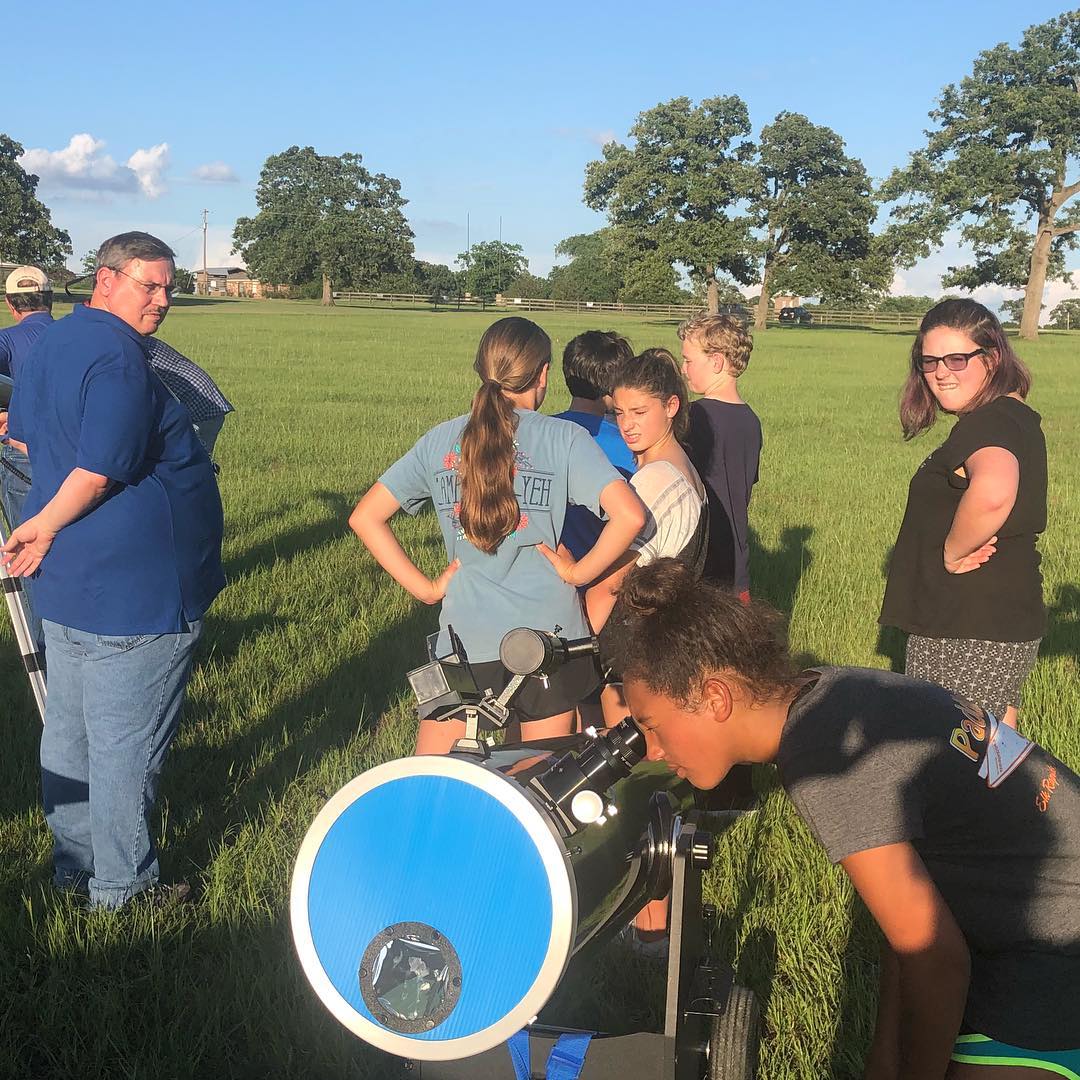
A few weeks ago, the Brazos Valley Astronomy Club received a request to come and show the night sky to a group of children attending a summer camp at Millican Reserve. We readily agreed and began making plans.
There would be three summer camps, and they were wanting us to attend each of them. The camps would be 12-14 year old children, which is a good age to learn some basic astronomical principles. For this first camp, she wanted us to be there two nights in a row.
Tonight was the first night of camp. Mark, Warren and myself showed up around 6:30pm to represent the club. Mark brought his 4-inch refractor, Warren brought his 10-inch Dob, and I came with Zoomie (12-inch dob) and Cutie (80mm refractor), which I had mounted on a GoTo system.
We were just finishing up with modifying our scopes for solar viewing when the campers arrived at our setup spot. We showed them the sun, which luckily had a tiny freckle of a sunspot on it. The two dobs and Mark's refractor showed it pretty well, but it was too small of a detail for the rear-projection sun funnel to pick out while mounted on Cutie.

We then turned the scopes towards the Moon, offering the kids a low-contrast daytime view. They were impressed with seeing all the craters, even though the gibbous phase showed most of them washed out by sunlight.
But now we needed to wait for the sky to get a little darker before we would be able to point out Venus or Jupiter.
Warren pulled out some washers of varying sizes from his pocket and asked for volunteers. When he arrived earlier, he had walked off distances to the inner planets from his telescope using a scale where the Sun was 6' in diameter and placed little flags in the field where the inner planets should be.
The volunteers picked the planet they wanted to be and took off towards their marker. Warren stretched out his arms and said, "This is the sun. Look how far away the planets are from each other." Mercury was within hearing distance of his shouts, but the kids portraying Venus and Earth had difficulty hearing him so the messages had to be relayed to them. This was a good glimpse into just how vast our solar system is.
One of the camp counselors was asking questions about my telescope, so I turned back to the moon with Zoomie and had him look through the finderscope and then the main telescope and see if he noticed any difference. Of course, he said the telescope view was much larger. So I asked him about the direction of the unlit portion of the Moon in both eyepieces. In the finderscope, the unlit portion was near the bottom of the moon, and in the Zoomie eyepiece, it was near the top of the Moon. I explained that the finderscope was a refractor, using lenses, whereas the telescope was a reflector and utilized mirrors, which flipped the image upside down.
Now we had to wait out in the hot sun for darkness. Andrea, our contact and one of the owners of Camp Millican was nice enough to bring us a couple large bottles of cold water and some plastic cups. I can't believe none of us had thought about bringing cold water ourselves. I guess we're too used to night-time observing.
While we waited, we noticed that the clouds along the horizon were increasing and heading our way. They were fairly high and thin, but were thickening a bit as the evening progressed. This didn't bode well for the rest of the night.
Finally the sky turned dark enough that Venus was visible. We turned our scopes to it and cranked up the magnification enough to cut some of its brightness and show its gibbous phase. The kids politely took turns looking through the telescopes at it, but I could tell they were less than impressed.
It was almost dark now and time for our ultimate showpiece, Jupiter. We turned all four scopes to the King of Planets. Even in Cutie, the main equatorial cloud bands were visible as were the four Galilean Moons. Three were on one side of Jupiter and the other was close to the planet on the opposite side.
The kids were really excited about this. But then I noticed a few of the moons disappearing. I looked up and noticed some clouds moving in to cover Jupiter. It kept trying to peek out here and there, but the clouds were winning this battle.
For the rest of the evening, we jumped back and forth between the Moon and Jupiter, depending on which one had the least clouds in front of it. We could occasionally make out other stars but I wasn't even able to point out an entire constellation due to clouds.
At one point, Mark pointed out that the cloud formation near the moon made it look like the moon was a rocket blasting off into the air. I quickly grabbed my cellphone and snapped a picture, but the clouds were already moving out of position. Still, you can kind of see it in the image I got:

Soon, it was 9pm and even though the skies were just starting to get good and dark, the clouds were hampering progress and it was time for the kids to be picked up by their parents. They thanked us and wandered back to their cabin while we packed things up for the night. Everyone had a lot of fun despite the clouds and not being able to see many targets. But tomorrow night was supposed to be clear, so I was hoping to maybe show them a star cluster or two.